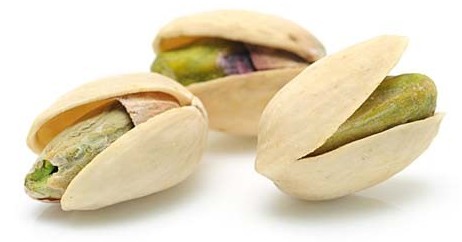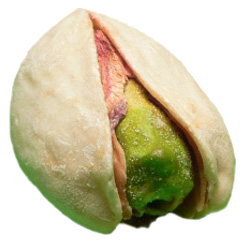

Pistachios

Pistacia. (From Greek pistake, pistachio.) PISTACHIO. Anacardiaceae. About nine species of dioecious trees and shrubs. Leaves alternate, deciduous or persistent, pinnate, rarely simple or trifoliate, membranous or leathery. Inflorescence a panicle or raceme, unisexual; bracts 1-3, herbaceous or membranous; petals absent; male flowers with stamens 3-8, usually 4-5, anthers ovate or oblong, filaments short, inserted on disc, pistillode reduced or absent; female flowers with ovary superior, globose or ovoid, unilocular, style 1, short, stigmas 3, occasionally 2, papillose, staminodes absent. Fruit an obovoid to globular drupe, often laterally compressed, fleshy; seeds 1, laterally compressed. Mediterranean, C Asia to Japan, Malesia, Mexico, S US. Z9 unless specified. CultivationPistacia vera has long been cultivated in its native regions, Western Asia and the Mediterranean; it is grown in Iran, Turkey and Syria, the major exporters of the nut, and in California, Arizona and Texas. It occurs in hilly and mountainous regions, to 1500m, with a temperature range between -10ºC in winter and 40ºC in summer, largely on sandstone formations, although it also enjoys a light calacreous soil in cultivation. It flourishes in conditions with long hot summers, low humidity and on poor soils. To set fruit, male and female plants must be grown, at a ratio of 1:5. In cool temperate climates, the genus is mainly represented by the ornamental Pistacia chinensis, the Chinese Pistachio. Reaching upwards of 20m, it is a popular shade tree in the southern US, but it is grown chiefly for its elegant and glossy foliage, which shows fine autumn colour. It survives in Washington DC. Pistacia chinensis is sometimes used as graft stock for Pistacia vera. The slow-growing Mediterranean native, Pistacia terebinthus, the source of China turpentine, can also be grown in cool temperate regions; it has handsome and aromatic glossy leaves. Pistacia lentiscus, also aromatic, the source of mastic, makes an evergreen shrub to 4m, requiring wall protection in cool regions. Plant hardy species in spring, in a sunny position, and in well drained deep light soil. Grow tender species in intermediate to hot glasshouse conditions, minimum 13-16ºC, in low humidity and direct light, in a well-drained loam-based medium. Water by drenching thoroughly and allow to dry moderately between waterings. Sow seed in late winter-early spring in loam-based seed propagating medium at 25ºc. Germination is variable. Sound fresh nuts must be soaked overnight in water before sowing; if the drupe is entire, soak overnight in alkalised water, and rub through a sieve or with coarse sand to remove the pulp. In commercial cultivation, choice varieties of Pistacia vera such as ‘Minnularia’, and ‘Fimminedda’ are propagated by budding or grafting. Dormant buds from old wood are budded on to year-old understocks of Pistacia vera, Pistacia terebinthus or Pistacia atlantica in spring, when the bark lifts freely. Selected female varieties are also grafted onto 2-3-year-old seedling understock of Pistacia terebinthus or Pistacia atlantica. Grafts bear fruit in their third or fourth year, and in alternate years thereafter. Since the plants are dioecious, a male branch is often grafted on simultaneously, or male branches may be gathered and preserved until the female flowers open, for pollination by hand; if pollination does not occur, shells continue to grow empty to normal size. 
Pistacia are more prone to fungal root rots than other members of the Anacardiaceae. Pistacia atlanticaBETOUM; MOUNT ATLAS MASTIC. Tree to 20m. Branches brown to grey. Leaves imparipinnate; leaflets 7-11, to 6 x 1.5cm, lanceolate, obtuse not mucronate; rachis winged. Male panicle to 10 x 4cm, compact, later loosening, bracts linear-lanceolate; stamens 5-7, anthers oblong-ovate; female panicle erect or ascending, 8-15cm, bracts 2-4, oblong-ovate, 1 bract lanceolate; ovary globose. Fruit obovoid, to 8 x 6mm. N Africa. variety latifolia. Tree to 15m. Leaves larger; leaflets 6-8, occasionally 9, lanceolate to oblong to broadly ovate. E Mediterranean. Pistacia chinensisTree to 15m, occasionally taller. Leaves deciduous, paripinnate; leaflets 10-20, around 8 x 2cm, lanceolate, strongly oblique a base, acute to acuminate, mucronate to cuspidate, terminal leaflet shorter; petiole 3-10cm. Male panicle puberulent, to 5 x 3cm; female panicle 8-18cm. Fruit scarlet becoming purple-blue, thinly fleshy. China, Taiwan, Philippines. subspecies integerrima. Leaves paripinnate or imparipinnate, 15-25cm; leaflets broadly lanceolate to oblong, slightly oblique at base, to 10 x 3.5cm. Afghanistan to Kashmir. Z8. Pistacia lentiscusMASTIC; LENTISCO; CHIOS MASTIC. Tree or shrub to 4m, evergreen. Leaves coriaceous, paripinnate; leaflets 4-6, rarely more, 15-45 x 6-16mm, glabrous, ovate,oblong-lanceolate or elliptic, obtuse to mucronate. Male inflorescence a raceme, sometimes branched, compact, 1-2.5cm, bracts pubescent, ovate to oblong, concave, stamens 4-5, pistil rudimentary; female inflorescence a raceme, sometimes branched, in clusters of 1-4, bracts triangular, ovate or oval, ovary ovoid. Fruit red becoming black, globose to lenticular, 4-5mm, fleshy. Mediterranean except NE Africa. Pistacia mexicana
Tree to 6m. Branches angular, pubescent, later glabrous. Buds coriaceous. Leaves imparipinnate, to 15cm; leaflets 16-36, 10-26 x 6-9mm, thin, often alternate, oblong, acute, mucronate, oblique, margins occaionally revolute, terminal leaflet smaller; petiole glabrous, 1-3cm. Male panicle compact, 5-8cm; bracts densely pubescent; stamens 4-5; female panicle 5-11cm. Fruit sessile, globose to lenticular, 4-6mm, red to black. Mexico, Guatemala. Pistacia terebinthusCYPRUS TURPENTINE; TEREBINTE; TEREBINTHO. Tree or shrub, 2-6m, deciduous. Leaves imparipinnate, 10-20cm; petiole to 8cm; leaflets 6-12, 3-5cm, ovate-lanceolate to oblong, obtuse or acute, mucronate, glabrous, veins pubescent. Male panicle 6-10 x 2-4cm, bracts brown, pubescent, oblong; female panicle diffusely branched, 15-20 x 8-15cm, bracts to 3.5mm, oblong-lanceolate. Fruit obovoid, to 7 x 6mm, slightly oblique, purple, wrinkled, thinly fleshy. Iberia to Turkey, Morocco to Egypt. variety marcocarpa. Fruit 7-9 x 7-9mm, more fleshy than species type. variety oxycarpa. Fruit attenuate, obovoid, acute, mucronate, 8 x 6mm. Pistacia texanaAMERICAN PISTACHIO; LENTISCO. Tree branching from base. Leaves 9-17, 5-10cm, imparipinnate, sessile, alternate, oblong, acute, mucronate, strongly oblique, membranous; leaflets 10-22 x 5-9mm, terminal leaflet smallest, midrib pubescent. Female panicle crowned, 4-7cm. Fruit dark brown, lenticular, 5-6mm broad, obliquely tipped, fleshy. S US, Mexico. Pistacia veraPISTACHIO; GREEN ALMOND; FUSTUQ. Tree to 10m, deciduous. Leaves 10-20cm, coriaceous, imparipinnate; petiole to 10cm; leaflets 3 or 5 , 5-12 x 3.7cm, glabrous or sparsely puberulent along midrib, broadly lanceolate to ovate, acuminate or acute, shining above, dull beneath. Male panicle compact, 5-8 x 2-3cm; female panicle looser and longer than male. Fruit long-pedicelled, oblong-linear to ovate, laterally compressed, variously coloured, often with red. W Asia. ‘Kerman’: vigorous, female, large easily opened nuts. ‘Peters’: recommended pollinator. ‘Sfax’: female, small nuts in large easily harvested clusters.
|
Home
Grow Herbs
Grow Fruit
Grow Vegetables
Cyberian Index
If you like this website and want one of your own contact
Cyberian All information correct at
time of publication and open to updates as necessary. No part of this website,
or its vectors, may be produced in any shape or form, using any type or design
of medium, system, equipment or otherwise without the prior written consensual
notice of the Cyberian. Any breach of these requirements will result in the
appropriate action. If in doubt, e-mail contact is recommended.
Some components of this website were obtained as open-source software and are
used in the same non-profit manner on this website.